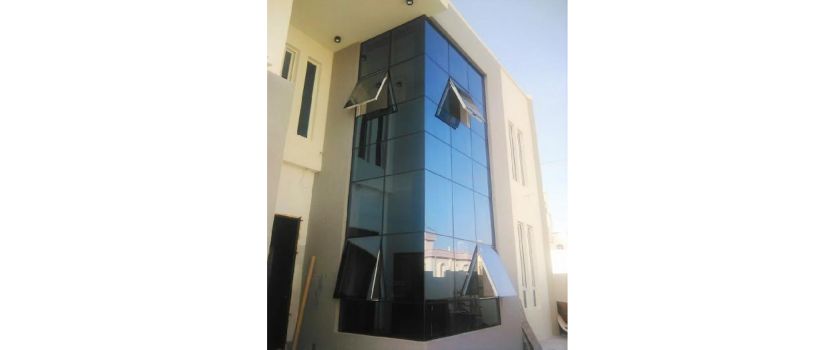-
+968-92849038, +968-93216645, +968-98099788 -
sales@alatonoman.com
What Do You Mean By Glass Structural Glazing?
Posted by Admin on February, 12, 2022

Glass buildings are very favourable when it comes to being environmentally friendly.
Structural glazing is a type of curtain that consists of glass that is anchored with the structure without the use of any gaskets. The structural glazing comes in various dimensions that are customised according to the requirements of customers. In this article, you will come to know more about glass structural glazing so please keep reading.
History of Glass Structural Glazing
Glass has been a significant feature in British architecture since the late mediaeval period, from which time the use of glass windows has grown to a point of near universality. Structural glazing however is a far more modern phenomenon, which has been made possible through advances in glass technology and building techniques.
In contemporary architecture, due to ever-developing load-bearing potential, glass can be used in ways that would previously be assumed impossible and in wholly innovative projects.
Where would structural glazing be used?
Structural Glazing is used astronomically, in skyscrapers, with glass facades ubiquitous characteristics in the financial centres of cities across the globe. As we have seen with the Shanghaied Glass Bridge, it is also being used in scenarios where architects aim to make the most extraordinary landscapes for the benefit of visitors. Chamonix Aiguille du Midi Skywalk, Austria’s "Stairway to Nothingness" are breathtaking examples of this trend.
However, structural glazing can also be incorporated in personal homes in a variety of architecturally innovative and visually captivating ways. Glass extensions are being increasingly adopted by homeowners as a way of increasing space and natural light without the frames and limited structural possibilities associated with a traditional conversion.
.
Different types of Structural Glazing
The types of Structural glazing
- Stick Glass Glazing
- Semi Unitized Glazing
- Spider Glazing
Stick Glass Glazing
A stick-type curtain wall glazing system is a kind of Structural Glazing where the frame verticals or the mullions and the glass panels are erected and connected piece by piece. It is one of the oldest curtain wall classes. The vertical mullions are connected first to the floor slabs and then the horizontal mullions are attached to the vertical ones.
The glass panel in the middle of the vertical and the horizontal mullions further with the spandrel which can be either glass or aluminium are then installed into the erected grid work. The visual effect of stick framing is frequently taken into account since there will be more vertical mullions taking the wind load than any other glazing system.
Usually, stick-type glazing is preferred for buildings that are not that tall, usually less than 3-4 floors. Air, wind, and heat can play a vital role in the stability and the stick glazing method takes these factors while they are built. Generally, the glass units between the aluminium frame slide when there is a thermal factor. This aspect is taken into consideration and provisioned when the glazing is done.
Advantages of Stick Glazing
- It is simpler than a glazing system when compared to other curtain wall glazing systems.
- The glazing can be fabricated off-site. This allows for less erection time than other curtain wall glazing systems.
Semi Unitized Glazing
A semi-unitized curtain wall glazing system is a kind of structural glazing where the primary structural framing elements are erected individually as an erector set. In this set, the vertical mullions are connected first to the floor slabs and the horizontals are linked to the vertical mullions to resemble a grid.
The glass panel and the spandrel, which can be either glass or aluminium are shop glazed and put in place into the assembled grid work. The joineries and perimeter sealants are fields put in place. The semi unitized systems are mostly anchored to the face of the slab as embedded plates or inserts.
Advantages of Semi-Unitized Glazing
- The vertical mullions in most semi-unitized glazing systems can range two floors with ease and as a result, supply greater structural efficiency.
- Mainly the semi-unitized glazing systems have shop-assembled or off-site assembled frames. This reduces the time and cost.
Spider Glazing
A spider Glazing is a part of the frameless glass system where they furnish a flush external appearance with uninterrupted views. Spider Glazing curtain walls furnish maximum daylight for building interiors as well as the possibility of placing huge transparent glass surfaces as building envelopes
Advantages of Spider Glazing System
Spider glazing offers maximum transparency and ensures the entry of natural light into the building interior. Therefore, spider glazing curtain walls are extensively used to provide daylight to commercial buildings. Being visually attractive they are also said to generate quality building skins.
Since they are available in unique design and allow brightness optimization. They are the number one choice for canopies, curtain walls and atriums. Owing to their easy installation and maintenance, spider glazing systems are mostly used in offices and building complexes. All uPVC doors and windows can easily be placed in spider glass areas.
This entry was posted on February, 12, 2022 at 10 : 57 am and is filed under Glass Structural Glazing. You can follow any responses to this entry through the RSS 2.0 feed. You can leave a response from your own site.
Search
Category
Recent Posts
- Add To The Outdoor Décor Aesthetics With Wooden Pergola
- Frameless Curved Glass Screen – Add more Energy to Interiors
- Install Frameless Glass shower Partitions To Experience A Truly Modern Bath
- What do you mean by Glass Structural Glazing?
- Advantages Of Installing The Beautiful Wooden Pergola In Your Backyard



